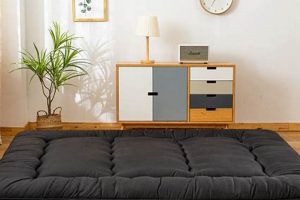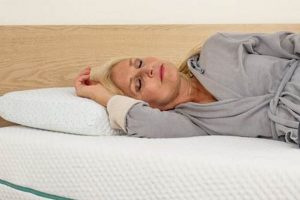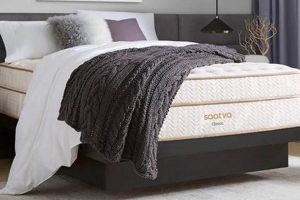Selection of a mattress designed to mitigate heat retention and promote airflow addresses thermal comfort during sleep. These mattresses often incorporate materials and construction techniques that dissipate body heat, contributing to a cooler sleep environment. For example, models featuring open-cell foam, gel infusions, or breathable fabrics fall into this category.
Maintaining an optimal sleep temperature is crucial for achieving restorative rest. Elevated body temperature can disrupt sleep cycles, leading to discomfort and potential sleep disturbances. The historical prevalence of uncomfortable, heat-retaining bedding underscores the significance of advancements in mattress technology aimed at temperature regulation. Such features contribute to improved sleep quality and overall well-being.
Considerations when choosing a temperature-regulating mattress include material composition, construction methods, and individual sleep preferences. The following sections will explore specific technologies and mattress types engineered to address thermal management during sleep.
Tips for Selecting a Temperature-Regulating Mattress
The following tips offer guidance when evaluating mattresses designed to minimize heat retention and maximize airflow for a cooler sleep experience.
Tip 1: Prioritize Breathable Materials: Mattresses incorporating natural latex, open-cell foam, or cotton covers promote superior airflow compared to traditional memory foam. These materials allow for better heat dissipation.
Tip 2: Consider Gel Infusions: Gel-infused memory foam aims to draw heat away from the body. However, note that the effectiveness of gel infusions can vary depending on the density and quality of the gel.
Tip 3: Evaluate Mattress Construction: Hybrid mattresses, combining innerspring coils with foam layers, typically offer better ventilation than all-foam mattresses. The coil system facilitates air circulation.
Tip 4: Assess Cover Fabric: Look for mattress covers made from breathable fabrics such as Tencel, bamboo, or performance knits. These fabrics wick away moisture and enhance airflow.
Tip 5: Check for Open-Cell Technology: Mattresses employing open-cell foam structures possess larger air pockets, improving ventilation and reducing heat buildup compared to closed-cell foam.
Tip 6: Investigate Phase Change Materials (PCMs): PCMs absorb and release heat, helping to regulate temperature. Some mattresses incorporate PCMs in their cover or comfort layers for enhanced cooling.
Tip 7: Account for Base Layer Ventilation: Verify that the mattress base or foundation allows for adequate airflow. Solid platforms may restrict ventilation compared to slatted or open foundations.
Selecting a mattress with appropriate thermal management features is paramount for achieving comfortable and restorative sleep. Careful consideration of the above factors will aid in identifying a suitable product.
The subsequent sections will delve into specific mattress types and technologies that further contribute to a cooler sleep environment.
1. Breathable Material Selection
The selection of breathable materials directly impacts a mattress’s ability to regulate temperature, a primary determinant of sleep comfort. Materials with inherent breathability facilitate airflow, mitigating heat retention and promoting a cooler sleep environment. This characteristic is crucial for mattresses marketed for cool sleeping, as it directly addresses the common issue of overheating during sleep.
For instance, natural latex, derived from rubber trees, exhibits an open-cell structure that allows for greater air circulation compared to traditional memory foam. Similarly, open-cell memory foam, though synthetic, is engineered with larger air pockets to enhance ventilation. Cotton and linen, when used in mattress covers, offer improved breathability and moisture-wicking properties compared to synthetic fabrics like polyester. The effect of these material choices is demonstrable in reduced heat buildup and improved thermal comfort for the sleeper.
In summary, breathable material selection constitutes a critical component in achieving optimal temperature regulation in mattresses. While other factors, such as mattress construction and technology, contribute to cooling performance, the fundamental role of breathable materials in promoting airflow cannot be overstated. Overlooking this aspect can lead to compromised temperature regulation and diminished sleep quality.
2. Optimal Airflow Design
Optimal airflow design constitutes a critical element in mattresses engineered for cool sleep. A mattress’s internal structure directly influences its capacity to dissipate heat and maintain a comfortable sleep temperature. Designs that prioritize unobstructed airflow facilitate the removal of body heat and moisture, preventing the accumulation of warmth that disrupts sleep.
Mattresses with open coil systems, such as traditional innerspring or hybrid models, inherently offer superior airflow compared to solid foam constructions. The spaces between the coils allow for continuous air circulation. Furthermore, the integration of ventilation channels or strategically placed air vents within foam layers enhances airflow, preventing heat from becoming trapped. For example, some memory foam mattresses incorporate convoluted foam layers with peaks and valleys, creating channels for air to circulate.
In conclusion, optimal airflow design is not merely a supplementary feature but an essential component of mattresses designed for cool sleep. The ability to efficiently circulate air through the mattress core directly impacts its capacity to regulate temperature and promote a comfortable sleep environment. Prioritizing airflow design is paramount when selecting a mattress intended to mitigate heat retention and facilitate restorative rest.
3. Effective Heat Dissipation
Effective heat dissipation is fundamental to the functionality of any mattress designed to promote a cool sleep environment. The ability of a mattress to efficiently remove body heat directly influences sleep comfort and quality. Mattresses failing in this aspect contribute to overheating, potentially disrupting sleep cycles and leading to restlessness.
- Material Thermal Conductivity
The thermal conductivity of mattress materials dictates the rate at which heat transfers through them. Materials with high thermal conductivity, such as copper-infused foam or certain types of gel, facilitate rapid heat transfer away from the body. Conversely, materials with low thermal conductivity, like dense memory foam without ventilation features, tend to trap heat, leading to increased sleep temperature. The choice of materials significantly impacts the mattress’s ability to effectively manage body heat.
- Airflow Convection
Airflow within a mattress creates convection currents that carry heat away from the sleeper. Open-cell foam structures and coil-based support systems promote airflow, facilitating heat dissipation. Mattresses with tightly packed, closed-cell foam impede airflow, hindering heat removal. The design and construction of the mattress must consider airflow pathways to maximize convective cooling.
- Moisture Management
Moisture, primarily sweat, can contribute to heat retention and discomfort during sleep. Mattresses with moisture-wicking covers and breathable materials facilitate the evaporation of sweat, preventing the buildup of humidity and promoting a cooler sleep surface. Materials like Tencel and wool are known for their moisture-wicking properties, contributing to improved heat dissipation.
- Surface Area Maximization
Increasing the surface area of the mattress exposed to airflow enhances heat dissipation. Features such as convoluted foam layers or ventilated mattress toppers increase the surface area available for heat exchange. This principle is based on the physics of heat transfer, where a larger surface area promotes faster cooling.
In summary, effective heat dissipation is a multifaceted characteristic, encompassing material selection, structural design, and moisture management. Mattresses marketed for their cooling properties must prioritize these elements to deliver on their promise of a comfortable and temperature-regulated sleep experience. The absence of effective heat dissipation renders a mattress unsuitable for individuals seeking to avoid overheating during sleep.
4. Moisture-wicking properties
The presence of moisture-wicking properties directly influences the efficacy of mattresses designed for cool sleeping. The human body naturally perspires during sleep, leading to moisture accumulation on and within bedding. Mattresses lacking moisture-wicking capabilities retain this moisture, creating a humid and warm microclimate that disrupts sleep. Consequently, mattresses intended for cool sleeping must effectively manage moisture to maintain a comfortable sleep temperature.
Materials such as wool, Tencel, and certain synthetic performance fabrics exhibit superior moisture-wicking characteristics. These materials draw moisture away from the body, facilitating its evaporation and preventing the buildup of humidity. A mattress cover constructed from such materials contributes significantly to a cooler sleep environment. For instance, a mattress cover made of Tencel can absorb moisture more effectively than a polyester cover, leading to a perceivable difference in sleep temperature. Furthermore, some mattresses incorporate moisture-wicking fibers within their comfort layers to enhance overall moisture management. This is especially critical for individuals prone to night sweats or residing in humid climates.
In summary, moisture-wicking properties represent a crucial component of mattresses designed for cool sleeping. The efficient removal of moisture prevents the formation of a warm and humid microclimate, contributing to a more comfortable and temperature-regulated sleep experience. Ignoring moisture-wicking capabilities in mattress selection can negate other cooling features and compromise sleep quality. Therefore, consideration of material composition and moisture-wicking performance is essential when evaluating mattresses intended to promote cool sleep.
5. Temperature Regulation Technology
The integration of temperature regulation technology represents a significant advancement in the design and functionality of mattresses aimed at promoting cool sleep. Such technologies proactively manage heat and moisture levels, fostering an environment conducive to restorative rest. Their presence often distinguishes mattresses capable of consistently delivering a cooler sleep experience from those relying solely on passive cooling mechanisms.
- Phase Change Materials (PCMs)
PCMs absorb or release heat as they transition between solid and liquid states at specific temperatures. In mattresses, PCMs are often integrated into the cover or comfort layers, where they absorb excess body heat, keeping the sleeper cool. Once the sleeper’s body temperature decreases, the PCM releases stored heat, preventing the sleeper from becoming too cold. This dynamic temperature regulation contributes to a more stable and comfortable sleep environment. For instance, a mattress incorporating PCM technology may feel cooler to the touch initially, and then maintain a consistent temperature throughout the night, adapting to changes in the sleeper’s body temperature.
- Gel Infusions
Gel-infused memory foam aims to draw heat away from the body. Gel particles, often made of silica, are dispersed throughout the foam matrix, increasing its thermal conductivity. This allows the foam to dissipate heat more efficiently compared to traditional memory foam. However, the effectiveness of gel infusions varies based on the concentration and type of gel used. Some gel infusions primarily provide a cooling sensation upon initial contact, while others offer more sustained heat dissipation. Its worth noting that the long-term cooling efficacy of some gel infusions is contested as the gel’s ability to continuously dissipate heat may diminish over time.
- Ventilated Foam Structures
Engineered ventilation within foam layers promotes airflow, facilitating heat dissipation. This can take the form of convoluted foam surfaces, strategically placed air channels, or open-cell foam structures. Ventilation allows for the continuous exchange of air, preventing heat from becoming trapped within the mattress. For example, a mattress with a convoluted foam layer, resembling an egg crate, creates channels for air to circulate beneath the sleeper’s body, reducing heat buildup. Similarly, open-cell foam structures inherently possess larger air pockets compared to closed-cell foam, promoting improved ventilation and heat removal.
- Active Cooling Systems
Some advanced mattresses incorporate active cooling systems that use fans or water circulation to regulate temperature. These systems actively remove heat from the mattress, providing precise temperature control. While less common due to their higher cost and complexity, active cooling systems offer the most effective means of maintaining a consistently cool sleep environment. An example includes mattresses with integrated fans that draw air through the mattress core, expelling warm air and introducing cooler air. Another example includes water-cooled mattresses, where chilled water circulates through a network of tubes within the mattress, providing continuous cooling.
These technologies, either individually or in combination, contribute significantly to a mattress’s ability to regulate temperature and provide a cooler sleep experience. The presence and effectiveness of these temperature regulation mechanisms often distinguish mattresses marketed as “best” for cool sleeping. Careful evaluation of these features is crucial when selecting a mattress designed to mitigate heat retention and enhance sleep comfort.
Frequently Asked Questions
The following section addresses common inquiries regarding mattresses designed to regulate temperature and promote cooler sleep.
Question 1: Does a higher price point guarantee superior cooling performance in mattresses?
While price can correlate with advanced materials or construction techniques, it is not a definitive indicator of cooling efficacy. Evaluate specific features such as material breathability, airflow design, and the presence of temperature regulation technology, irrespective of price. Independent testing data and customer reviews offer valuable insights into real-world performance.
Question 2: How does mattress firmness impact temperature regulation?
Mattress firmness indirectly affects temperature regulation. Firmer mattresses tend to minimize body sinking, promoting greater airflow around the sleeper and reducing heat buildup. Softer mattresses, conversely, may contour more closely to the body, potentially restricting airflow and increasing sleep temperature. Individual preferences and sleep position should guide firmness selection, keeping temperature regulation in mind.
Question 3: Are gel-infused mattresses universally effective at providing cooling?
The cooling effectiveness of gel-infused mattresses varies significantly depending on the type, concentration, and distribution of the gel. Certain gel infusions provide a transient cooling sensation upon initial contact, while others offer more sustained heat dissipation. Consider the specific properties of the gel infusion and consult user reviews to assess real-world performance. Not all gel infusions deliver a tangible improvement in sleep temperature.
Question 4: How do different sleep positions influence the need for a temperature-regulating mattress?
Sleep position affects heat distribution and airflow. Stomach sleepers may experience greater heat buildup due to increased surface contact with the mattress. Back sleepers generally benefit from enhanced airflow. Side sleepers typically experience moderate heat distribution. The selected mattress should address the specific temperature regulation needs associated with the primary sleep position.
Question 5: Can a mattress protector negate the cooling benefits of a temperature-regulating mattress?
Yes, certain mattress protectors can impede airflow and diminish the cooling properties of a temperature-regulating mattress. Choose a breathable mattress protector made from materials such as Tencel or cotton. Avoid waterproof protectors made from non-breathable materials like vinyl or plastic, as these can trap heat and moisture.
Question 6: How often should a temperature-regulating mattress be rotated or flipped?
Mattress rotation frequency depends on the construction and materials. Many modern mattresses are designed to be non-flippable. However, rotation, typically every three to six months, can promote even wear and prevent localized compression, potentially maintaining consistent airflow and temperature regulation. Refer to the manufacturer’s recommendations for specific rotation guidelines.
In summary, selecting a temperature-regulating mattress requires consideration of various factors beyond marketing claims. Informed evaluation of materials, construction, and individual sleep preferences is essential for optimizing sleep comfort and temperature.
The following section explores the long-term maintenance and care of temperature-regulating mattresses to ensure sustained performance.
The Importance of Selecting the Best Mattress for Cool Sleeping
This exploration has underscored the multi-faceted nature of selecting the best mattress for cool sleeping. It has traversed material science, airflow dynamics, and advanced temperature regulation technologies to illuminate the factors influencing sleep temperature. Material breathability, effective heat dissipation, and moisture-wicking properties stand out as critical performance characteristics that must be carefully evaluated when choosing a product designed to mitigate heat retention.
The pursuit of optimal sleep temperature is an investment in long-term health and well-being. As research continues to advance our understanding of the sleep-temperature nexus, consumers are encouraged to critically assess available options and prioritize data-driven decision-making when choosing the best mattress for cool sleeping. The selection of a temperature-regulating sleep surface merits diligent research and evaluation.






![Top-Rated Best Sleeping Mattress for Camping: [Year] Guide Organic & Natural Mattress Buyer’s Guide: Non-Toxic Sleep Solutions Top-Rated Best Sleeping Mattress for Camping: [Year] Guide | Organic & Natural Mattress Buyer’s Guide: Non-Toxic Sleep Solutions](https://mattressworldpa.com/wp-content/uploads/2025/07/th-1737-300x200.jpg)
